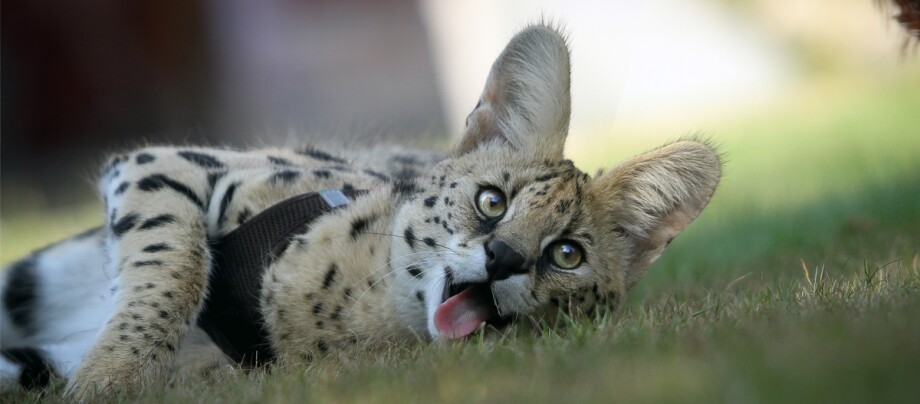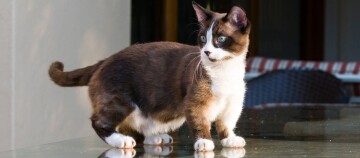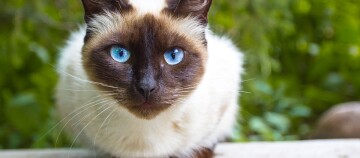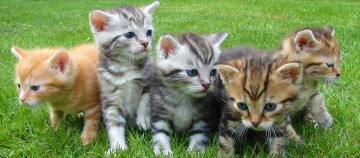Servals – African Wild Cats Smaller Than Cheetahs, Yet Far From Tame
01.01.2024 - Reading time: 3 minutes

Servals are African wild cats – smaller than lions or cheetahs, yet far from being tame. Nevertheless, some private individuals keep Serval cats as pets. Often this is done to breed so-called Savannah cats by crossing them with Siamese cats. Keeping a Serval cat in a species-appropriate manner is a highly demanding task that the average cat lover can hardly fulfil. Moreover, keeping them is subject to registration and regulations.
NewsletterServal
Breed | Serval |
Origin | African Savannah cat |
Size | 75 to 100 cm (head-torso length), 45 to 62 cm shoulder height |
Weight | 9 to 18 kg (tomcat), 7 to 12 kg (female cat) |
Physique | slender, long-legged, long neck |
head shape | small skull with large “bat ears” |
Eyes | brownish, greenish |
Coat and colour | round spots on an ochre/sand background |
Coat care | occasional brushing (for tame animals!) |
Nature | solitary, wild, reserved |
Special features | very long legs, short tail |
Owning | Enclosure with special permit |
Serval: nature
Servals are solitary animals. They only roam in pairs during the mating season. The animals are semi-nocturnal, always alert and skilled stalkers. Servals always retain their wild animal character and are not considered to be domesticated. Accordingly, they are shy, reserved, more dominant and aggressive than domestic cats, although in individual cases a certain familiarity with known people can develop, for example in hand-reared cats. A Serval might be cuddly and playful towards such persons. If a wild cat is driven to play, it will usually do so at night and with a corresponding temperament.
Keeping and care of the Serval
First of all: A Serval is not suited as a house cat, even if you forego cuddling and playing sessions. Being a predatory cat, it can only be house-trained in exceptional situations during the kitten stage. The animal needs a large, escape-proof outdoor enclosure (at least 50 to 100 square metres) with a heated indoor area, trees to climb and a large watering hole. Other than these purely spatial (and financial) requirements, keeping servals in Germany requires a permit, and is even completely prohibited in Bavaria and Hesse. The housing conditions are more like those of a zoo animal than a domestic cat.
Servals need special attention when it comes to nutrition: It is essential for them to eat fresh meat, which means you have to feed them raw food (BARF). Without extensive knowledge, you will be unable to meet the nutritional needs of the Serval.
Servals are not suitable play companions for children and pets. The wild cat can seriously injure even a larger domestic cat during play. Also, Servals mark their territory and, if necessary, their human owner.
If, despite everything, you are not dissuaded from acquiring such an animal, please ensure that you have a traceable certificate of origin – all too often, wild cats are traded illegally. Important: Familiarise yourself with the official regulations in your region before purchase.
Colours of the Serval
The basic colour of the Serval cat is always ochre or sand. There are black spots all over the body, which vary greatly in size. Some Servals have a speckled pattern, although the dark areas can also be so large and blend into each other that they actually appear striped or even black from a distance. Also, the white spots on the back of their ears are known as wild spots.
The history of the Serval cat
Serval cats were once common throughout Africa except in desert areas; today, they are no longer found in the northern countries of the continent. Serval cats are typical savannah dwellers, preferring tall grassy areas and waterholes to hunt small animals, fish and birds. Although Servals in the wild are not considered to be acutely endangered, the loss of natural habitat is having an impact on them.
Special features of the Serval cat
Serval cats possess an almost unbelievable jumping ability: they can jump up to three metres vertically to grab birds from the air, and 3.60 metres in the distance. For this reason, a Serval cat enclosure must be fenced very high and be escape-proof. The Serval cat has the longest legs of all cats in proportion to the rest of its body, but a rather short tail.





